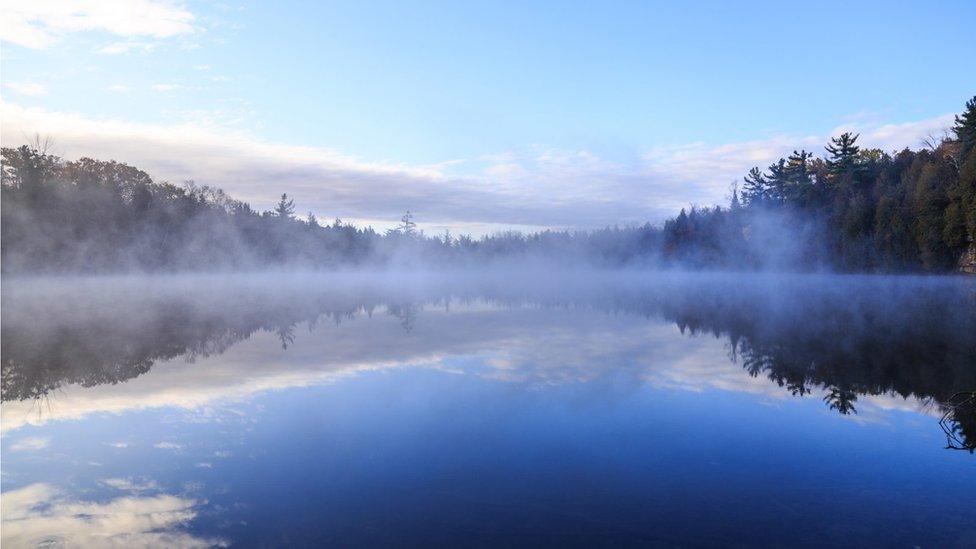The Anthropocene: What is an epoch and are we about to enter a new one?
- Published
- comments

Crawford Lake is a limestone sinkhole that has filled with water
Some scientists believe we might have entered a new geological age heavily influenced by human activity on the planet.
It's likely you've heard of the Ice Age and the Stone Age, but what about the Anthropocene?
Scientists are trying to work out, by looking at rocks, whether we've entered a new geological time period or not.
Rocks can tell us a lot about the history of our planet and experts say a small lake in Ontario, Canada, is potentially the best place to test out their theory.
That's because it's full of mud that captures excesses of things we use as humans, like fossil fuels, so it's a good place to see how much of our activity on Earth has had an impact on the environment.
What is a geological time period?
In order to better understand different periods of history, the entirety of time on Earth is divided into smaller chunks.
These chunks of history have different names, depending on the length of time they are describing.
They're measured by looking at layers of rock in the Earth.
Eons
Eras
Periods
Epochs
Ages
Rocks can tell us a lot about our ancient history
If you examine the layers, you can see over time that different things - like certain minerals and fossils - are really common at one point, and then are less common at another.
The study of this is called stratigraphy, and the layers of rock are called strata.
The word Anthropocene comes from the Greek word anthropo, which means 'man', and cene, which means 'new'
What is the most recent time period called?
The most recently named time period is the Holocene epoch, which started roughly 11,700 years ago, shortly after the last Ice Age.
At this point, our climate became more stable, which can be seen in the strata from around that time.
The Ice Age was a period when global temperatures were very cold
Why do some scientists think we've entered a new epoch?
Scientists have seen a big change in the top layers of rock they're studying, (the ones that formed most recently).
They've named it the Anthropocene epoch, anthropo meaning relating to human kind and cene meaning new.
They believe it marks the start of heavy human influence on our planet starting in the 1950s.
Technology, such as televisions, became widely available in the 1950s
The 1950s was at the beginning of the Great Acceleration, a period when people started creating more technology, using more materials and when the global population grew rapidly.
However, not all scientists agree we've entered a new epoch. Some think the Anthropocene is potentially no different from the Holocene.
The International Union of Geological Sciences (IUGS), which is the group that names and defines epochs, has yet to officially adopt the term Anthropocene.
What's so special about Crawford Lake?
Crawford Lake is a limestone sink hole that has filled with water
A team of experts has nominated Crawford Lake in Ontario, Canada, as the best place to monitor the Anthropocene.
It was chosen from a shortlist that included a peat bog in Poland and a coral reef in Australia.
However, for it to become the official monitoring site, three more scientific organisations need to nominate it.
Crawford Lake is a 24m deep lake, but isn't very wide, so the muddy bottom is completely undisturbed.
Professor Francine McCarthy, who studies the lake and is a member of a team called the Anthropocene Working Group (AWG), said: "The bottom of the lake is completely isolated from the rest of the planet, except for what gently sinks to the bottom and accumulates in sediment."
They've seen microplastics, ash from coal-fired power stations and heavy metals such as lead.
One important chemical they've found is plutonium.
Samples sent to Southampton will show when plutonium first appears
This radioactive element is found in nuclear weapons, which was only used from 1945 onwards - since the Second World War.
Mud samples from Crawford Lake have been sent to Southampton in the UK to test for plutonium, to see which year it first appeared.
The AWG says that date could help them pick an exact year for the potential start of the Anthropocene.
- Published9 July 2023
- Published7 March 2022
